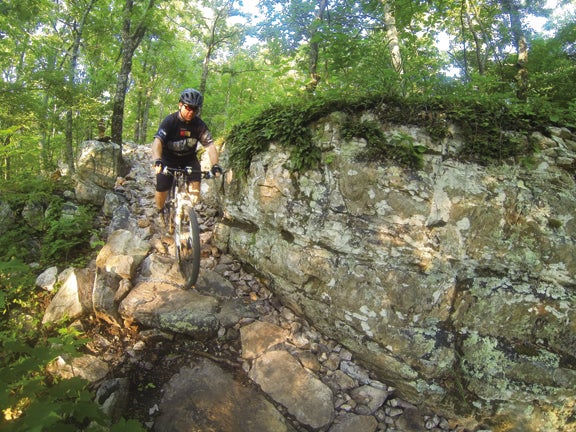Forever Wild Spotlight: Coldwater Mountain Doug Ghee Nature Preserve and Recreational Area
Mountain bike mecca and wildlife preserve scrape the sky in Calhoun County
By Kenny Johnson, ADCNR
Coldwater Mountain rises above Anniston, Ala., as the Appalachian chain emerges from northeast Alabama. The stillness of this tectonic monument is deceptive if viewed from a distance. But visitors to the mountain’s surface soon experience the thrill that only human-powered wheels and gravity can provide. Since becoming a Forever Wild Land Trust property and nature preserve in 1998, plans have been in the works to transform Coldwater Mountain into an inter- national mountain biking magnet.
Now, thanks to intense planning and hard work executed through various public/private partnerships, knobby tires are hitting the trails, and according to riders, it been worth the wait. Alabamians and riders from across the county are be- ginning to take notice of Coldwater Mountain’s trails. In May 2013, the National Park Service designated the trail system as a National Recreation Trail highlighting it as an excep- tional trail of local and regional significance.
Laura Colbert from Loose Nuts Cycles in Atlanta, Ga., has experienced Coldwater Mountain and describes it as a great ride. “It’s a great combination of easy and challenging trails,” she said. “The long trail up the mountain offers some real challenges, but I also saw some small kids very happily riding the shorter trails. I’ve already recom- mend that other riders visit Coldwater.”
Richard Edwards, Trail Solutions Manager for the In- ternational Mountain Biking Association (IMBA), has overseen the trail design, planning and construction at Coldwater Mountain.
“We learned from past projects and incorporated the best design practices from places like Park City, Utah and Tamarack, Idaho, and optimized the trails for fun,” Edwards said. “We wanted to make this a tourism destination that adds value to the local community by offering a variety of different trail difficulties. When the trails are finished, no matter what skill level you are as a rider or where you live in the county, Coldwater Mountain will offer something for everyone.”
MOUNTAIN BIKING MECCA
A future trail connector is planned from Coldwater Mountain to downtown Anniston. When completed, bikers and hikers from across the country could take an Amtrak train into Anniston and access the trail directly from their hotel. With the Talladega National Forest, the Chief Ladiga Trail, and the Pinhoti Trail so close to Coldwater Mountain, Anniston has the potential to become a hiking/mountain biking mecca in the Southeast.
There are currently more than 20 miles of trail open, and a proposed 40 miles to be constructed over the next several years. There is no running water or a bathroom at the trailhead, and the gate is locked about an hour after sunset, so plan your trip accordingly. The trails are open 365 days a year and are free to use. The trails are open to mountain bikers and hikers, but motorized vehicles and horses are prohibited.
ADDITIONAL ACTIVITIES
Hiking and mountain biking aren’t the only outdoor activities available on the mountain. With 4,083 acres, Cold- water Mountain also serves as a nature preserve. The most common habitat in the preserve is dry oak-hickory woodland. Dominant tree species include sand and pignut hickory as well as blackjack, rock chestnut, and black oak. Common midstory and understory plants of this upland habitat are sourwood, sparkleberry, and low-bush blueberry. Stands of longleaf pine pepper the oak-hickory woodland in the higher elevations. The mountain is also home to a few plant species considered sensitive in the state or rarely seen on the tract including smooth purple aster, purple coneflower, wild gooseberry, kidneyleaf grass-of-parnassus, Boykin’s milk- wort, and Alabama cherry.
Alabama is a birder’s paradise and Coldwater Mountain is no exception. Examples of species hikers can expect to see include red-tailed and Cooper’s hawk; chuck-will’s-widow; Eastern whip-poor-will; common nighthawk; ruby-throated hummingbird; Acadian and great-crested flycatcher; Eastern wood-pewee; Eastern phoebe; red-eyed, yellow-throated, and white-eyed vireos; brown creeper; winter wren; oven- bird; yellow-throated, black-and-white, Kentucky, hooded, black-throated green, and pine warblers; chipping sparrow; and scarlet and summer tanagers.
In addition to common mammals such as white-tailed deer, Coldwater Mountain is home to many interesting am- phibians and reptiles including spotted salamander (in high elevation vernal pools), Webster’s salamander, spotted dusky salamander (springs and seeps), mountain chorus frog, green frog, American toad, box turtle, Eastern garter snake and timber rattlesnake.
This mountain also serves as a major watershed protection for Coldwater Spring, one of the largest springs the state in terms of volume, producing 31 million gallons of water per day. The spring is home to the pygmy sculpin, a federally protected fish found nowhere else in the world.
The Coldwater mountain trail system has many partners: the Alabama Department of Conservation and Natural Resources, the Alabama State Lands Division, the Forever Wild Land Trust, Anniston Water Works and Sewer Board, Alabama Department of Economic and Community Affairs, Northeast Alabama Bicycle Association (NEABA), International Mountain Biking Association, Southern Off-Road Bicycle Association, Alabama Department of Transportation, Alabama Power Company, and the City of Anniston.
DIRECTIONS
From I-20, take Exit 179 (Coldwater/Munford Exit). Travel north for 2.1 miles and turn right onto Cold- water Pump Road. Travel a few hundred yards and turn right onto new black-top paved road. Travel 1 mile to the Coldwater Mountain parking area.
For more information about new trail developments, visit the NEABA website.
Coldwater Mountain Video produced by the IMBA

Photo by Bobby Phillips, Northeast Alabama Bicycle Association
